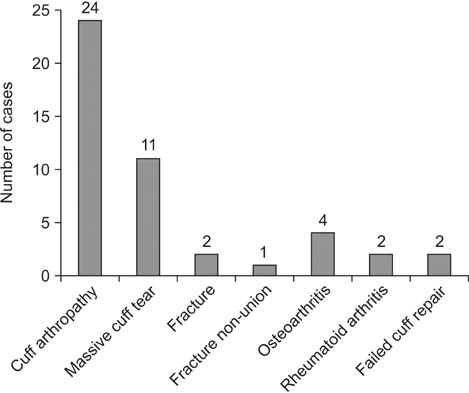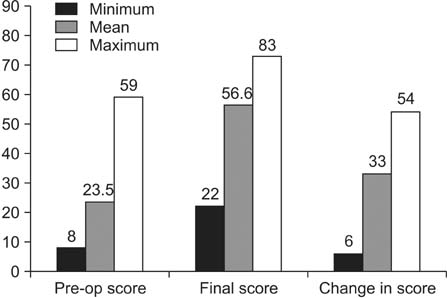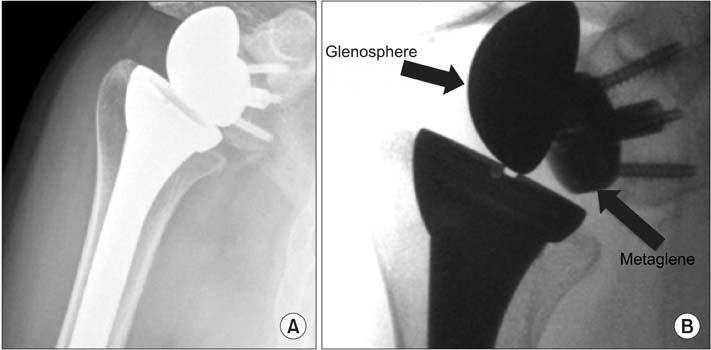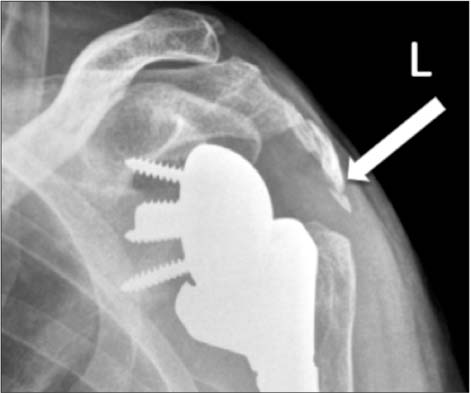Clin Orthop Surg.
2015 Sep;7(3):359-364. 10.4055/cios.2015.7.3.359.
Delta Reverse Polarity Shoulder Replacement: Single Surgeon Experience with a Minimum 2-Year Follow-up
- Affiliations
-
- 1Department of Trauma and Orthopaedic Surgery, Diana Princess of Wales Hospital, Grimsby, UK. shahjehan200@gmail.com
- KMID: 2234091
- DOI: http://doi.org/10.4055/cios.2015.7.3.359
Abstract
- BACKGROUND
The delta reverse shoulder replacement system was developed for the treatment of rotator cuff arthropathy so that the deltoid can substitute for the deficient rotator cuff. To evaluate the results of delta reverse shoulder replacement for functional improvement and complications in a consecutive series by a single surgeon over a period of six years with a minimum follow-up of 2 years.
METHODS
The data were collected retrospectively from electronic theatre records. Over a period of 6 years (2006-2012), 46 cases that fulfilled the inclusion criteria were identified. There were 34 females and 12 males. The average age of patients was 76.2 years (range, 58 to 87 years). A single surgeon performed all procedures using the anterosuperior approach. The mean follow-up time was 49 months (range, 24 to 91 months). All cases had preoperative and postoperative Constant scores. We collected the data on indications, hospital stay, and change in the Constant score, complications, and reoperation rates.
RESULTS
The main indication for surgery was rotator cuff arthropathy (52.2%), followed by massive rotator cuff tear (28.3%), osteoarthritis (8.7%), fractures (6.5%), and rheumatoid arthritis (4.3%). Also, 65.2% of the cases were referred by general practitioners, 26% of the cases were referred by other consultants, and 8.8% of the cases were already under the care of a shoulder surgeon. The average preoperative Constant score was 23.5 (range, 8 to 59). The average Constant score at the final follow-up was 56 (range, 22 to 83). On average, there was an improvement of 33 points in the Constant score. The improvement in the Constant score was significant (p < 0.001). We observed complications in four patients (8.6%). Three of four patients (6.5%) needed reoperation. The first complication was pulmonary embolism in the early postoperative period. The other complications included dissociation of the glenosphere from the metaglene, deltoid detachment, and stitch abscess.
CONCLUSIONS
This is a single-surgeon, single-approach series of 46 cases with a minimum follow-up of 2 years. At this stage, the results are encouraging with no cases of loosening, dislocation, or nerve injury.
Keyword
MeSH Terms
Figure
Reference
-
1. Vanhove B, Beugnies A. Grammont's reverse shoulder prosthesis for rotator cuff arthropathy: a retrospective study of 32 cases. Acta Orthop Belg. 2004; 70(3):219–225.2. Grassi FA, Murena L, Valli F, Alberio R. Six-year experience with the Delta III reverse shoulder prosthesis. J Orthop Surg (Hong Kong). 2009; 17(2):151–156.
Article3. Neer CS 2nd, Craig EV, Fukuda H. Cuff-tear arthropathy. J Bone Joint Surg Am. 1983; 65(9):1232–1244.
Article4. Burkhart SS. Arthroscopic treatment of massive rotator cuff tears: clinical results and biomechanical rationale. Clin Orthop Relat Res. 1991; (267):45–56.5. Walch G, Madonia G, Pozzi I, Riand N, Levigne C. Arthroscopic tenotomy of the long head of the biceps in rotator cuff ruptures. In : Gazielly DF, Gleyze P, Thomas T, editors. The cuff. Paris: Elsevier;1996. p. 350–355.6. Pollock RG, Deliz ED, McIlveen SJ, Flatow EL, Bigliani LU. Prosthetic replacement in rotator cuff-deficient shoulders. J Shoulder Elbow Surg. 1992; 1(4):173–186.
Article7. Grammont PM, Baulot E. Delta shoulder prosthesis for rotator cuff rupture. Orthopedics. 1993; 16(1):65–68.
Article8. Flatow EL, Harrison AK. A history of reverse total shoulder arthroplasty. Clin Orthop Relat Res. 2011; 469(9):2432–2439.
Article9. Grammont P, Trouilloud P, Laffay JP, Deries X. Concept study and realization of a new total shoulder prosthesis. Rhumatologie. 1987; 39:407–418.10. Naveed MA, Kitson J, Bunker TD. The Delta III reverse shoulder replacement for cuff tear arthropathy: a single-centre study of 50 consecutive procedures. J Bone Joint Surg Br. 2011; 93(1):57–61.11. Bohsali KI, Wirth MA, Rockwood CA Jr. Complications of total shoulder arthroplasty. J Bone Joint Surg Am. 2006; 88(10):2279–2292.
Article12. Valenti P, Sauzieres P, Katz D, Kalouche I, Kilinc AS. Do less medialized reverse shoulder prostheses increase motion and reduce notching? Clin Orthop Relat Res. 2011; 469(9):2550–2557.
Article13. Cazeneuve JF, Cristofari DJ. Delta III reverse shoulder arthroplasty: radiological outcome for acute complex fractures of the proximal humerus in elderly patients. Orthop Traumatol Surg Res. 2009; 95(5):325–329.
Article14. Flury MP, Frey P, Goldhahn J, Schwyzer HK, Simmen BR. Reverse shoulder arthroplasty as a salvage procedure for failed conventional shoulder replacement due to cuff failure: midterm results. Int Orthop. 2011; 35(1):53–60.
Article15. Wall B, Nove-Josserand L, O'Connor DP, Edwards TB, Walch G. Reverse total shoulder arthroplasty: a review of results according to etiology. J Bone Joint Surg Am. 2007; 89(7):1476–1485.16. Zafra M, Uceda P, Flores M, Carpintero P. Reverse total shoulder replacement for nonunion of a fracture of the proximal humerus. Bone Joint J. 2014; 96(9):1239–1243.
Article17. Werner CM, Steinmann PA, Gilbart M, Gerber C. Treatment of painful pseudoparesis due to irreparable rotator cuff dysfunction with the Delta III reverse-ball-and-socket total shoulder prosthesis. J Bone Joint Surg Am. 2005; 87(7):1476–1486.
Article18. Neer CS 2nd. Replacement arthroplasty for glenohumeral osteoarthritis. J Bone Joint Surg Am. 1974; 56(1):1–13.
Article19. Reeves B, Jobbins B, Flowers F, Dowson D, Wright V. Some problems in the development of a total shoulder endoprosthesis. Ann Rheum Dis. 1972; 31(5):425–426.
Article20. Neer CS 2nd, Watson KC, Stanton FJ. Recent experience in total shoulder replacement. J Bone Joint Surg Am. 1982; 64(3):319–337.
Article21. Katz D, O'Toole G, Cogswell L, Sauzieres P, Valenti P. A history of the reverse shoulder prosthesis. Int J Shoulder Surg. 2007; 1(4):108–113.
Article22. Fenlin JM Jr. Total glenohumeral joint replacement. Orthop Clin North Am. 1975; 6(2):565–583.
Article23. Fenlin JM. Semi-constrained prosthesis for the rotator cuff deficient patient. Orthop Trans. 1985; 9:55.24. Baulot E, Sirveaux F, Boileau P. Grammont's idea: the story of Paul Grammont's functional surgery concept and the development of the reverse principle. Clin Orthop Relat Res. 2011; 469(9):2425–2431.
Article25. Kalouche I, Sevivas N, Wahegaonker A, Sauzieres P, Katz D, Valenti P. Reverse shoulder arthroplasty: does reduced medialisation improve radiological and clinical results? Acta Orthop Belg. 2009; 75(2):158–166.26. Bufquin T, Hersan A, Hubert L, Massin P. Reverse shoulder arthroplasty for the treatment of three- and four-part fractures of the proximal humerus in the elderly: a prospective review of 43 cases with a short-term follow-up. J Bone Joint Surg Br. 2007; 89(4):516–520.27. Cuff DJ, Pupello DR. Comparison of hemiarthroplasty and reverse shoulder arthroplasty for the treatment of proximal humeral fractures in elderly patients. J Bone Joint Surg Am. 2013; 95(22):2050–2055.
Article28. Holcomb JO, Hebert DJ, Mighell MA, et al. Reverse shoulder arthroplasty in patients with rheumatoid arthritis. J Shoulder Elbow Surg. 2010; 19(7):1076–1084.
Article29. Rittmeister M, Kerschbaumer F. Grammont reverse total shoulder arthroplasty in patients with rheumatoid arthritis and nonreconstructible rotator cuff lesions. J Shoulder Elbow Surg. 2001; 10(1):17–22.
Article30. Middernacht B, De Wilde L, Mole D, Favard L, Debeer P. Glenosphere disengagement: a potentially serious default in reverse shoulder surgery. Clin Orthop Relat Res. 2008; 466(4):892–898.
Article
- Full Text Links
- Actions
-
Cited
- CITED
-
- Close
- Share
- Similar articles
-
- The radiographic and clinical outcomes of stemless reverse total shoulder arthroplasty: a minimum 2-year follow-up study
- Subscapular and Pectoralis Major Sparing Deltopectoral Approach for Reverse Total Shoulder Arthroplasty
- Reverse Total Shoulder Arthroplasty: Complications
- Reverse Total Shoulder Arthroplasty in Patients with Severe Rotator Cuff-Deficient Shoulder: A Minimum Three-Year Follow-up Study
- Uncommon Indications for Reverse Total Shoulder Arthroplasty






